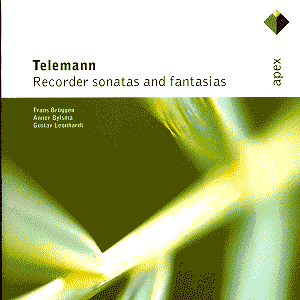The recorder was one of the first instruments
to be rediscovered as part of the growing interest in ‘early music’
at the beginning of the 20th century. "When, after about
160 years of neglect, it began to regain some of its popularity
as a result of the singing movement in the 1920s and 1930s, it
was largely considered to be an instrument that was easy to play
and thus ideally suited to amateur music-making. However, the
recorder groups of the youth music schools often deterred people
from learning to play the instrument," writes Martin Elste
in the booklet. As he rightly says, it was in particular the Dutch
recorder player Frans Brüggen who, in the early 1960s, was
able to turn the recorder into an instrument which was taken seriously
among professional musicians. He not only devoted his attention
to the interpretation of music of the renaissance and the baroque,
on original instruments he collected, or on copies of those instruments,
but also encouraged contemporary composers to write works for
the recorder.
Two circumstances worked in his favour – apart
from his own great musical skills, of course. He cooperated with
two first class musicians who thought along the same lines in
regard to the interpretation of early music, namely the cellist
Anner Bijlsma and the harpsichordist Gustav Leonhardt. For many
years they gave concerts all over the world and made a huge impression
on their audiences. The second factor was that the record company
Telefunken started its early music series ‘Das Alte Werk’. It
gave Brüggen, Bijlsma and Leonhardt the opportunity to record
baroque music on period instruments.
This CD presents a collection of pieces which
were recorded during the 1960s and early 1970s. There is no information
on the recorders used here – all treble recorders – which is a
shame, since many of them are probably original historical instruments.
It is no wonder the whole disc is devoted to
Telemann. He wrote many pieces for the recorder, an instrument
he very likely played himself (Telemann could play many of instruments).
They were part of several collections with chamber music, like
‘Der getreue Music-Meister’ (1728-29) (TWV 41:F2, B3, f1, C2)
and the ‘Essercizii Musici’ (1739-40) (TWV 41:C5, d4). The Fantasias
were originally written for the transverse flute, as the title
says: "12 Fantasies à Travers, sans Basse" (1732-33).
In his recordings Brüggen has transposed them to make them
playable on the recorder. I have added the original keys in the
track list.
I regret that no information is given as to when
each piece was recorded. The booklet only states that 4 of the
fantasias were recorded in 1969 and 1971. Listening to this CD
from beginning to end, there is a clear development in the interpretation.
It seems to me that the Sonatas in F (F2), B flat (B3) and d minor
(d4) are the earliest. The recording of these contains considerably
more noise and there is a strong separation of the left and right
channel (left: recorder, right: basso continuo). The interpretation
in the earlier recordings is characterised by a pretty strong
vibrato in the recorder playing and relatively little ornamentation.
Interestingly, though, one of the features of the continuo playing
of Bijlsma and Leonhardt – the strong ‘drive’ – is already there.
Among the highlights of this collection are the
Fantasias, which are played brilliantly. Here Brüggen plays
with more freedom and imagination and a strong sense of the rhetorical
character of these pieces. He is really telling a story on his
recorder.
What is this recording all about: Telemann or
Brüggen? I would say that the early recordings really can’t
compete with more recent recordings of this repertoire. The Fantasias,
on the other hand, certainly can. But I would like to recommend
this CD above all as testimony to the art of Frans Brüggen,
who not only played a key role in the emancipation of the recorder,
but also – through the large numbers of pupils – had a considerable
influence on the development of the historical performance practice.
Johan van Veen

